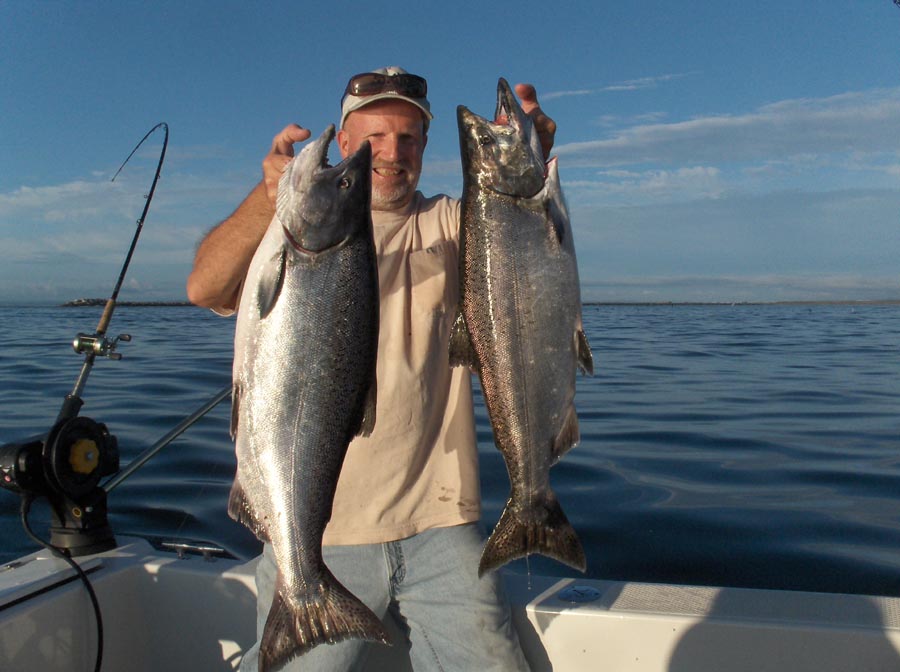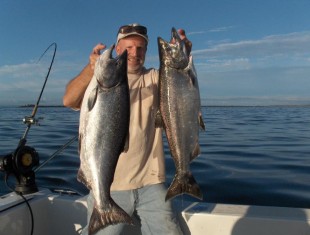EARL SANDE WITH TWO KINGS
About ten years ago I discovered a large toad hanging around the front yard during the summer months. I would only see it at night, usually near the outside light by the shop. The light may have attracted insects as a source of food.
By looking at some pictures in a northwest frog and toad book I was certain it was a Western Toad, and probably a female because of its large size. She didn’t seem to be afraid of me so I did get a close look from three feet away.
It showed up every summer for five years in a row. At least it looked like the same one. After that I never saw it again. It may have died of old age or gotten eaten by some hungry predator.
One afternoon last summer I found another one near the house, only this one was much younger being about three inches long. I grabbed my camera and got some good pictures of it.
Then in February I found one about three inches long on the concrete floor just inside my shop, so I grabbed a rag and took it a hundred feet into the brush and put it on an old stump.
I wondered just how far these toads had to travel to get here from where they had left a pond after their tadpole stage. The ponds near our property usually dry up by late spring, probably long before a tadpole could develop into a toad. There is a year around pond across highway 3 half a mile away and another a mile away near the Bremerton National Airport, but that seemed like a long and difficult ways away.
Now that the once abundant Western Toad population is vanishing from the western United States some studies are being done on them. Biologists have put tiny transmitters on some to determine how far they travel. One walked five miles going about two hundred yards a day while some traveled for two to four miles. Some others in excellent habitat went 2-5 hundred yards during the year looking for food.
Western Toads are members of the family Bufonidae and are considered “true toads.” Adults range from three to five inches long with the females usually being larger. They have dry, soft bumpy skin and are mostly light brown and grey with a little red on some of the warts. They also have a whitish stripe down their back going from head to tail.
Mature toads have a gland behind each eye that can excrete a foul tasting toxic substance that only the hungriest of predators can stomach. The hind feet have small claw like appendages that help when digging out a place to hide or spend the cold winter months. They are stocky looking and can jump pretty well but prefer a gentle slow walk when traveling.
Like most frogs and toads they will eat pretty much anything alive that crawls, walks or flies that they can catch and easily swallow whole. During the tadpole stage they eat only aquatic plants and algae. Like a few other species of frogs and toads the Western Toad tadpoles look black in the water.
They are sexually mature at about three years of age, but females only reproduce every 1-3 years and might only do this once in their lifetime. They can lay 12,000 eggs usually in shallow water because that’s where the water is warmest. They hatch in about two weeks and with a little luck they turn into toads in about two months. They have also been known to spawn in the same pond during their lifetime.
In the wild they can live to be at least 12 years old, but one lived in captivity for thirty-five years.
A hundred years ago this species could be found in a huge area west of the Rocky Mountains from Mexico to Alaska and from sea level to high in the mountains.
But human development and the Western Toad combination isn’t going so well. Herbicides, pesticides and fertilizers easily go through their skin killing them. These chemicals also kill the tiny creatures the toads eat.
Loss of habitat plus hundreds of thousands of miles of roads the toads have to cross to get to where they want to go makes for lots of toad pancakes. It might not be long before they only exist where people don’t.
There are lots of things we could do to save the Western Toads from local extinction, but we can’t save everything. It is just too expensive and besides most people don’t even know they exist so they won’t miss them anyway.
But if given a chance nature can be pretty amazing.


